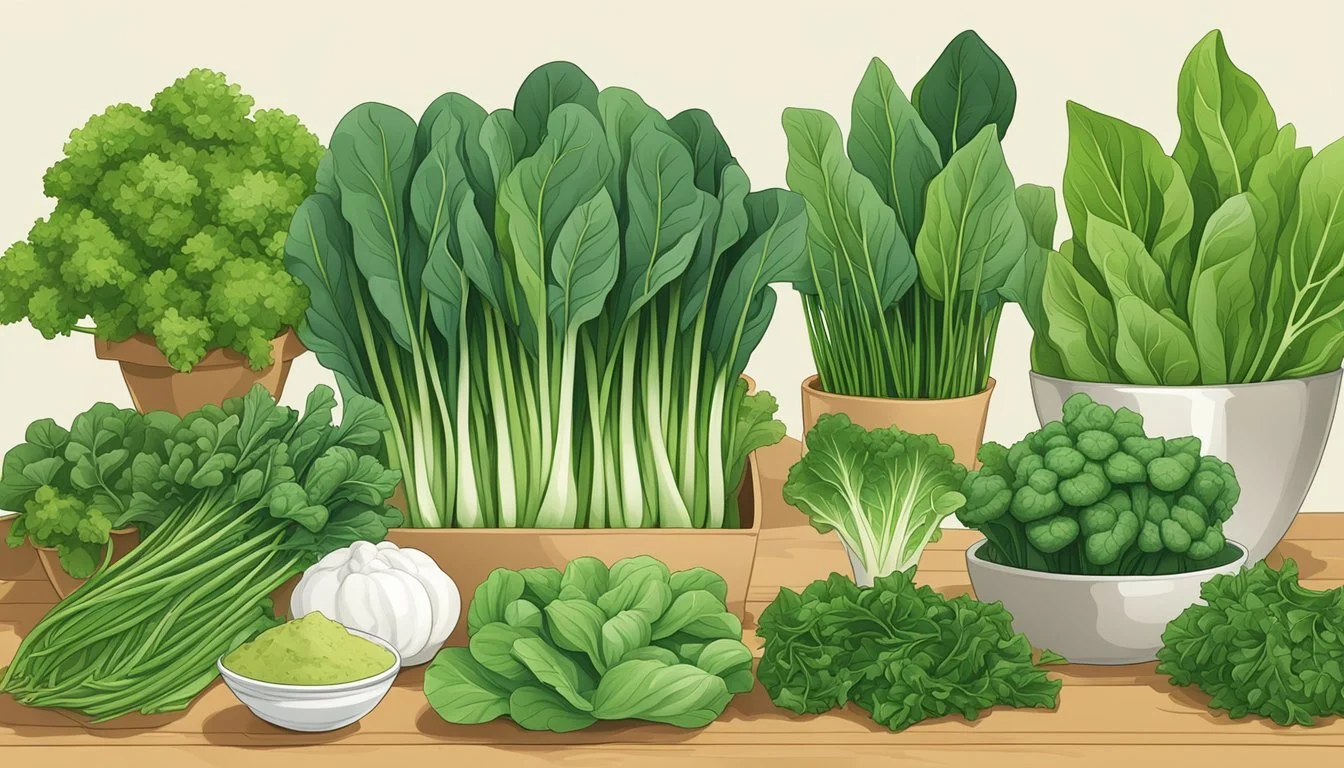Water Spinach Substitutes
Best Alternatives for Asian Recipes
Water spinach, also known as kangkong, is a popular leafy green vegetable in many Asian cuisines. It's known for its tender texture and unique flavor, making it a favorite in stir-fries, soups, and salads. Like spinach, water spinach offers nutritional benefits, including high levels of vitamins A and C, iron, and calcium. For those times when water spinach is not available, there are several excellent substitutes that can be used in its place.
Kale is a versatile and nutritious alternative to water spinach. It has a similar taste and can be used in a variety of dishes, from simple salads to complex stir-fries. Kale's hearty texture holds up well in cooking, making it a suitable substitute in warm dishes. Another good option is Swiss chard, which offers a comparable flavor profile and can be used similarly in recipes like soups and sautés.
Arugula, with its slightly peppery taste, also works well as a water spinach substitute, particularly in raw applications like salads and pizzas. Though it has a different flavor, arugula can bring a new dimension to dishes, making your meal both visually appealing and nutritious.
Culinary Profile of Water Spinach
Water spinach, a nutrient-rich leafy green, is celebrated for its versatility in various dishes. This green vegetable is popular in many culinary cultures for its distinctive texture and mild flavor.
Characteristics and Flavor Profile
Water spinach has long, tender stems and narrow, pointed leaves. The stems can be crisp and crunchy, while the leaves are softer. When cooked, water spinach retains a pleasant crunchiness, making it ideal for diverse dishes.
The flavor is often described as mild, with a hint of bitterness that balances well with other ingredients. This green can absorb and complement the flavors of sauces and spices, enhancing the taste profile of any recipe.
Common Culinary Uses
Water spinach is widely used in soups, stir-fries, and salads. In stir-fries, it pairs well with garlic, chilies, and soy sauce, providing both texture and flavor. Soups often feature water spinach to add a fresh, green element.
In salads, water spinach can be used raw or lightly blanched. Its tender leaves and crunchy stems add variety to the dish. Additionally, it can be sautéed with simple seasonings or added to omelets and stews for a nutritious boost.
Nutritional Comparison
When comparing substitutes for water spinach, it is essential to look at their nutritional profiles to make informed decisions. This section highlights the differences and similarities in vitamins, minerals, and caloric values among various substitutes.
Vitamins and Minerals Content
Substitutes like kale, beet greens, and collard greens often match or surpass water spinach in certain vitamins and minerals.
Kale: Rich in Vitamin A, Vitamin C, Vitamin K, calcium, and iron. It offers a concentrated amount of antioxidants beneficial for overall health.
Beet Greens: Comparable to water spinach in Vitamin A and Vitamin C. They are also high in iron and calcium.
Collard Greens: High in Vitamin K, calcium, magnesium, and substantial amounts of fiber. These nutrients support various bodily functions, including bone health and clotting.
Other substitutes like butterhead lettuce and curly endive provide different vitamin and mineral profiles but may lack the high concentration found in greens like kale and beet greens.
Caloric and Nutritional Value
Water spinach is known for its low-calorie content and high nutritional value, making it an excellent choice for those looking to maintain a healthy diet. Most substitutes share similar properties.
Caloric Values:
Kale: Approximately 35 calories per cup.
Beet Greens: Around 8 calories per cup.
Collard Greens: About 12 calories per cup.
Nutritional Values:
Kale: High protein content (2.9g per cup) and rich in fiber (2.6g per cup).
Beet Greens: Lower in protein (0.8g per cup) but provide significant fiber.
Collard Greens: Approximately 1.1g of protein per cup and high in dietary fiber.
Each substitute offers unique nutritional benefits, allowing for a diverse and nutrient-rich diet by incorporating them in place of water spinach.
Best Substitutes for Water Spinach
When looking for alternatives to water spinach, several leafy greens can replicate its taste and texture with minor variations, each bringing its unique qualities to a dish.
Closest Flavor and Texture Alternatives
Spinach is a popular substitute due to its similar mild taste and soft texture. Both can be used in a variety of cooked dishes without overpowering flavors.
Swiss Chard offers a slightly earthy and sweet flavor, making it a good choice for stir-fries and sautéed dishes. Its leaves have a firm texture that holds up well during cooking.
Kale adds a somewhat bitter note and a tougher texture but pairs well in soups and stews where it can soften over time. It's a robust green that retains its shape even after prolonged cooking.
Collard Greens have a mild, cabbage-like flavor. They work well when slow-cooked or braised, making them ideal for hearty dishes.
Common Recipes and Pairings
In stir-fries, Spinach and Swiss Chard are excellent choices. They cook quickly and meld seamlessly with other ingredients like garlic and soy sauce.
For soups and stews, Kale is a superior option. Its bitterness and sturdy texture enhance rich, broth-based dishes without disintegrating.
In braised dishes, Collard Greens shine, particularly when cooked with ham hocks or bacon, adding depth and a southern flair.
Salads benefit from baby Spinach due to its tender leaves and neutral taste, allowing other flavors to dominate.
Each substitute brings unique benefits, making them versatile choices tailored to specific culinary needs and preferences.
Health Considerations of Substitutes
When substituting water spinach in a diet, it’s essential to consider the health benefits and potential dietary restrictions associated with each alternative. These factors help in maintaining balanced nutrition and addressing specific health concerns.
Comparison of Health Benefits
Many leafy greens serve as excellent substitutes for water spinach, offering varied nutritional value. For instance, collard greens are rich in vitamins A, C, and K, as well as calcium and fiber, supporting bone health and digestion. Swiss chard has a high quantity of antioxidants which play a role in reducing inflammation and lowering the risk of chronic diseases like cancer.
Beet greens are another good option, containing substantial amounts of iron, manganese, and vitamins A, C, and K. This combination promotes immune function, skin health, and overall vitality. Arugula, known for its peppery flavor, provides similar health benefits, with additional phytonutrients that may aid in detoxifying the body.
Addressing Dietary Restrictions
For those with specific dietary needs, not all substitutes for water spinach may be suitable. People with vitamin K restrictions, such as those on blood thinners, may need to moderate their intake of greens like collard greens and beet greens, which are high in this nutrient.
Individuals with oxalate-related concerns, such as those prone to kidney stones, might prefer arugula or watercress, which have lower oxalate levels compared to spinach and Swiss chard. Furthermore, those following a low-fiber diet should consider the digestive impact of high-fiber greens and adjust their intake accordingly.
These considerations ensure that dietary choices align with both health goals and any medical advice, providing a balanced approach to replacing water spinach in meals.
Growing and Availability
Water spinach, also known as Ipomoea aquatica, is a versatile plant that can thrive in various climates. It is popular in many cuisines, particularly in South and Southeast Asia.
Seasonality and Regional Availabilities
Water spinach grows best in warm, tropical, and subtropical regions. In North America, it is primarily found in southern states, where there is sufficient heat and humidity. The plant typically flourishes during the spring and summer when temperatures are high.
In the Mediterranean, water spinach also grows well due to the warm climate. Availability can vary depending on local growing conditions and regulations, as water spinach is considered an invasive species in some areas. Local farmers' markets and specialty Asian grocery stores often carry it in these regions.
Foraging and Cultivating Tips
Foraging water spinach can be done in regions where the plant is naturally abundant. Look for it near rivers, streams, and wetlands. Be cautious and aware of local guidelines to avoid harvesting in protected areas.
Cultivating water spinach requires warm temperatures and plenty of water. The plant thrives in both soil and water, making it suitable for hydroponic systems. Ensure that the growing area has full sunlight and the soil is kept moist. Regular watering and occasional fertilization can significantly boost growth and yield.
Tables and lists can be handy to organize information about water spinach. Here is a brief cultivation guideline:
Preferred Conditions:
Temperature: Warm (above 75°F/24°C)
Light: Full sun
Soil: Moist, fertile
Water: Regular watering or hydroponics
By adhering to these tips, water spinach can be successfully grown either for personal use or for sale in local markets.
Innovative Cooking Ideas
Substituting water spinach offers a chance to explore diverse culinary styles and elevate everyday recipes with fresh twists. Whether incorporating these substitutes into global dishes or reinventing common meals, creativity brings remarkable flavor and texture.
Using Substitutes in Global Cuisines
Water spinach substitutes can add unique touches to various global cuisines. For instance, kale and spinach shine in Italian dishes like pesto, where they blend seamlessly with garlic, nuts, and olive oil.
In Korean cooking, collard greens can be fermented to create a distinctive kimchi, delivering bold flavors. Swiss chard works excellently in Mediterranean stews, resembling the hearty and nutritious quality of traditional greens. Arugula's peppery taste enhances Middle Eastern wraps and salads, bringing new dimensions to classic recipes.
Creative Twists in Common Dishes
Reimagining common dishes with water spinach substitutes leads to exciting culinary innovations. Substitute kale or Swiss chard in quiches for a nutritious twist, while beet greens can revamp a vegetable lasagna. They maintain the dish's structure but provide a different flavor profile.
For a vibrant smoothie, blend spinach or watercress with fruits for an energetic start to the day. Curly endive makes an excellent topping for pizza or sandwiches, adding crunch and freshness. Using arugula in pesto sauce offers a spicy, fresh take, perfect for pasta or as a spread for wraps. Substitutes breathe new life into these everyday recipes with minimal effort.
Additional Substitute Recommendations
When looking for substitutes for water spinach, consider Arugula. It has a peppery flavor and works well in salads and cooked dishes.
Watercress is another excellent choice. Its slightly spicy taste and high water content make it perfect for soups and salads.
Bok Choy is versatile and can be used in stir-fries or steamed, similar to water spinach.
For a more pungent option, try Mustard Greens. They add a unique flavor to dishes and hold up well in cooking.
Beet Greens look almost identical to spinach when cooked, making them a perfect visual and taste substitute.
Cabbage and Chinese Cabbage provide a crunchier alternative. They can be used in both fresh and cooked forms.
Lettuce, especially Romaine and Butterhead, offer a mild flavor and can be substituted in raw dishes.
For a slightly bitter taste, Curly Endive and other members of the Chicory Family, like Dandelion Greens, can be excellent choices.
Purslane is another unique substitute with a slightly sour and salty flavor, adding diversity to your meals.
Consider Nasturtium Leaves as well. They bring a peppery flavor and vibrant color to any dish.
Baby Spinach and Upland Cress are mild in taste and can be used in a variety of culinary applications.
Early Yellow Rocket adds a mustard-like flavor, beneficial for more robust dishes.
Lastly, Indian Cress, with its spicy flavor, can be a good substitute for those looking for a bit of heat in their meals.






